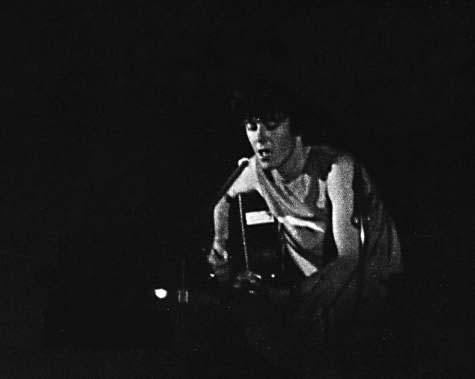WHEN THE CIVIL RIGHTS MOVEMENTS WAS FUSED WITH FOLK SONG IN THE EARLY SIXTIES, IT WAS LABELLED "PROTEST". THE FOREMOST EXPONENT OF THE FORM WAS BOB DYLAN UNTIL HE OFFENDED FOLK PURISTS BY "GOING ELECTRIC" CIRCA 1965. BY THEN, HE HAD MOVED FROM ANTI-NUCLEAR TRACTS TO RAPID-FIRE "STREAM-OF-CONSCIOUSNESS" LYRICS THAT WERE JOLTING POP'S UNDER-USED BRAIN INTO QUIVERING, RELUCTANT ACTION.
The Byrds, Manfred Mann and other groups dipped into portfolio of songs, and even tin-pan alley hacks put their minds to Dylan-type creations to win the approbation - and cash - of the blossoming hippy sub-culture.
Partly through Dylan, lyrics to later Sixties pop songs became less boy-meets-girl. Epitomizing this were the Pink Floyd's 'Arnold Layne' (a transvestite washing-line larcenist) and the abstract 'A Whiter Shade Of Pale' by Procol Harum - while the Move's 'Night Of Fear', Heroin' by the Velvet Underground, and the Small Faces' effervescent 'Itchycoo Park' implies drug experience beyond mere pills and reefers.

The growing lyrical complexity was reflected musically as groups progressed from guitars and drums to effects pedals, mellotrons and nascent monophonic synthesizers. Indeed, one of the reasons the Beatles ceased touring in 1966 was that their output had become impossible to reproduce in concert using conventional beat group instrumentation. Before George Harrison's sitar lessons with Ravi Shankar, Indian raga and deliberately induced guitar feedback had been first absorbed by the Kinks and the Yardbirds. The latter also superimposed Gregorian chant and other eruditions on to their artistic grid but syncretic Sgt. Pepper's Lonely Hearts Club Band that intensified the notion of pop as an egghead activity.
The most lasting effect of the watershed year of 1967 was the beginning of a transfer of emphasis from 45s to albums. Previously, the latter format had been a cynical and throwaway display of an artist's "versatility" but of no real cultural value. However, with the Beatles' continuing success, it dawned on record companies that it was a false economy not to allow best-selling acts longer time and greater freedom in the studio. The consequent output of many groups betrayed a conscious musical progression with an increasing ratio of album tracks the equal of single A-sides in terms of effort and imagination. Sometimes this policy backfired. The Yardbirds' 'Happenings Ten Years Time Ago', for example, put the tin lid on their chart career. Some considered it an aural nightmare while others shared one pundit's claim that it was "possibly the greatest 45 ever released". Of the same vintage, the Pretty Things's 'Mellowing Grey' was as warm with jarring vignettes of music spliced together to coalesce a half-sung narrative. Wilfully uncommercial, it lacked a discernible melody line as it darted from section to dissoluble section.
Nevertheless, albums by both outfits were well received critically, selling steadily if somewhat unremarkably.
By 1967, other humble pop outfits had become pseudo-mystics, dictating shifts in musical - and social - consciousness. Taking the signals they were given, fans took up meditation, vegetarianism, yoga or whatever else the pop in-crowd were currently "into". Fleetingly, you were convinced - as arch flower - child Donovan was - that God had seen "all the ugliness that was being created and had chosen pop to be the great force of love and beauty".
During this dawning of the Age of Aquarius, rock passed hastily through its classical period. With lack of a preceding article a la mode, combos such as Infinite Staircase, Pneumatic Bliss, Tea-And-Symphony and Iron Butterfly intimated musical insights not immediately comprehensible as sitars whined, tapes looped and the Mothers Of Invention inquired, 'Who Are The Brain Police?'
US acts of this bent entertained at the "be-ins", "freak-outs", "Mantra-rock dances" and "love-ins" that were held in the parks and transformed ballrooms around the Haight-Ashbury -"Hashbury"- district of San Francisco, now as vital a pop Mecca as Merseyside had been. Hit singles of 1967 by Eric Burdon, Scott McKenzie and the Flowerpot Men all paid tribute to the "flower power" city from whence sprang big-selling psychedelic albums by such as Jefferson Airplane and the Grateful Dead.
With the inevitable commercialization of flower power, San Francisco became clotted with drug pedlars, teenage runaways and traffic snarl-ups as curiosity-seekers and weekend trippers kept the freshly sprouted record stores, boutiques and restaurants in profit. By winter, Hashbury was all over.
Supplanted in Britain by slouch-hatted Al Capone chic, airy-fairy flower power turned out to be no more the dawning of the Age of Aquarius than the twist had been
Some rock acts had been either opposed or insensible to the shifts in stylistic parameters. As demonstrated by 'Purple Shades', a Troggs' 45 concerning "the bamboo butterflies of yer mind", others adjusted themselves to psychedelic without really getting the point. Conversely, "quality" entertainers started sifting through the sheet music, LPs and, if lucky, demo tapes of the more innovative rock composers. The Doors' 'Light My Fire' became something of a cabaret standard but a more obvious example was the Beatles' 'Yesterday'. An international star since 1938, Peggy Lee had been among the first in the queue for Kink Ray Davies's 'I Go To Sleep', 15 years before the Pretenders.
Paradoxically, 1967 also embraced a return to decent music. Tinpan alley tunesmiths were particularly pleased when crooner Engelbert Humperdinck's 'Release Me' kept the Beatles' double-sided meisterwerk 'Penny Lane'/'Strawberry Fields Forever' from Number 1 in Britain as his 'The Last Waltz' would Traffic's pixified 'Hole In My Shoe' a few months later. However, counter-revolutions of schmaltz like this only widened the chasm between "rock" - strictly for cultivated minds - and vulgar "pop".
